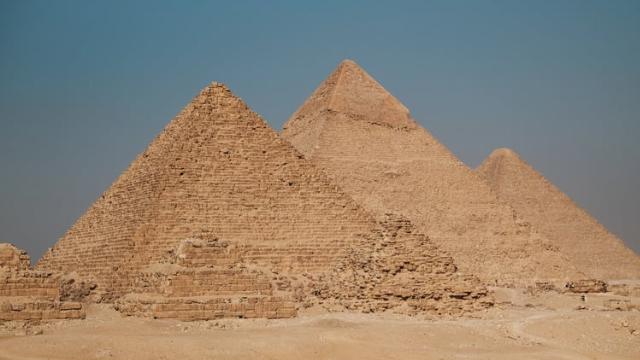The Egyptian pyramids are among the most significant structures of ancient civilization and continue to be a subject of great fascination. Built as tombs for pharaohs, the pyramids were constructed with great ceremony.
Among the most famous Egyptian pyramids are the Great Pyramid of Giza, the Pyramid of Khafre, and the Pyramid of Menkaure. The Great Pyramid, built for Pharaoh Khufu (Cheops), is known as one of the Seven Wonders of the Ancient World. Its passages, chambers, and corridors are filled with yet-undiscovered mysteries.
One of the mysteries surrounding the Egyptian pyramids is how they were constructed with such precise engineering. There remains uncertainty about how the stones were transported and placed during construction. Another mystery is their purpose and construction. While some argue that the pyramids served solely as tombs for pharaohs, others speculate they may have had multiple functions.
Additionally, various legends and speculations exist about hidden chambers, secret passages, and buried treasures within the pyramids. However, uncertainties persist regarding the extent to which these legends reflect reality or shed light on the true purpose and construction process of the pyramids.
The Egyptian pyramids and their mysteries have long captured the interest of archaeologists, historians, and enthusiasts, with further research and discoveries expected in the future.

Size: Egyptian pyramids are among the largest structures of the ancient world. Some of them reach heights of hundreds of meters.
Burial Chambers: Pyramids contain burial chambers where the mummified bodies of pharaohs and their treasures were placed.
Exceptional Construction: Pyramids were built using sophisticated construction techniques for their time. They were constructed by precisely placing large stone blocks.
Limestone: Egyptian pyramids were typically made of limestone blocks. These stones were sourced near the Nile River and served as the primary material for pyramid construction.
Entrance Passages: Pyramids feature hidden passages and chambers inside them. Secret chambers containing the pharaoh's burial were incorporated within the pyramid's structure.
Early Dynastic Period (c. 3150–2686 BC): The first step pyramid, known as the Djoser Pyramid, was built during this period under the rule of Pharaoh Djoser. It was designed by the architect Imhotep and marked the transition from mastaba tombs to pyramid structures.
Old Kingdom (c. 2686–2181 BC): This period is often referred to as the "Age of the Pyramids." The famous pyramids at Giza, including the Great Pyramid of Khufu (Cheops), the Pyramid of Khafre (Chephren), and the Pyramid of Menkaure (Mycerinus), were built during this time. These colossal structures served as tombs for the pharaohs and are some of the most iconic monuments in human history.
Middle Kingdom (c. 2055–1650 BC): Pyramid building continued during this period, but they were smaller in scale and less grand compared to those of the Old Kingdom. Many of the pyramids constructed during this era are located in the region of Dahshur, such as the Bent Pyramid and the Red Pyramid.
New Kingdom (c. 1550–1070 BC): Pyramid construction declined during the New Kingdom, and pharaohs began to build rock-cut tombs in the Valley of the Kings instead. However, some rulers still constructed small pyramids as part of their mortuary complexes, such as those at Tanis and Lisht.
Late Period and Ptolemaic Period (c. 664–30 BC): By this time, the tradition of pyramid building had long been abandoned, and other burial practices were favored. The last Egyptian pyramids were constructed during the late period but were much smaller and less significant compared to their ancient predecessors.
The interior of Egyptian pyramids typically consists of a complex arrangement and generally comprises three main sections:
Entrances and Passageways: One or several entrances on the exterior of the pyramid provide access to passageways that extend inward. These passages often lead to a main corridor that provides access to the burial chamber or other chambers within the pyramid's interior. Speculations exist about the presence of traps or hidden chambers within these passages in some pyramids.
Inner Chambers and Rooms: Within the interior of the pyramid, a series of chambers may be found. These chambers are usually utilized as the burial chamber and may contain the pharaoh's mummy and burial treasures. Some pyramids may feature multiple chambers serving different purposes.
Void Spaces and Burials: Certain pyramids may contain visible but inaccessible void spaces or chambers within their interior. These voids and chambers might result from alterations made during the construction or subsequent modifications. Additionally, speculations exist about the presence of hidden chambers or burial chambers within the interior of some pyramids, although these claims have yet to be substantiated.
Each pyramid's interior may vary slightly, with each structure having its own unique design and arrangement. Archaeologists and experts continually work to understand and uncover the interiors of pyramids.
The Egyptian pyramids were built by skilled laborers, artisans, and thousands of workers, primarily during the Old Kingdom period of ancient Egypt. They were constructed under the direction of the pharaohs, who were the rulers of ancient Egypt. While the exact methods of construction are still debated by historians and archaeologists, it is clear that the construction of these monumental structures required meticulous planning, organization, and considerable resources over many years. The labor force likely included skilled craftsmen, engineers, and a large number of laborers who were conscripted or paid for their work. The names of the individual architects and builders responsible for each pyramid are largely unknown, as they were not typically recorded in ancient Egyptian texts.
How many tons are 1 stone of the Egyptian pyramids?
Are the tops of the pyramids gold?
How old are the Egyptian pyramids?
Egyptian pyramids height
In which city are the Egyptian pyramids located?